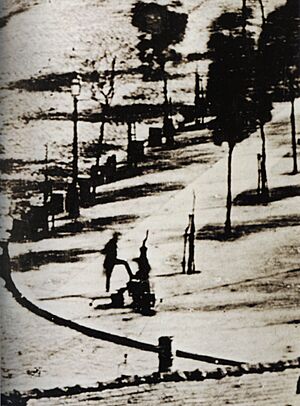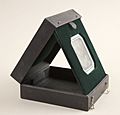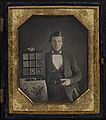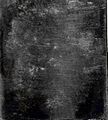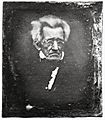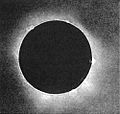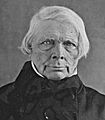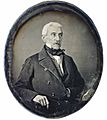Daguerreotype facts for kids
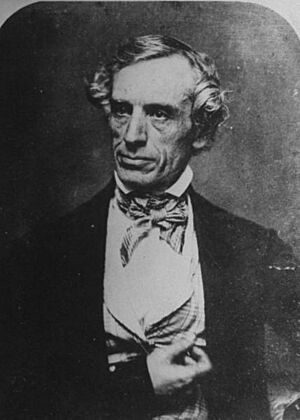
A Daguerreotype was an early way to make photographs. It's not used anymore today. A French artist named Louis-Jacques-Mandé Daguerre created this special photography method in France in 1839.
This new kind of photography quickly became very popular. People loved that it could capture a "truthful likeness" of someone. This meant the pictures looked exactly like the person. By 1850, there were more than seventy daguerreotype studios in New York City alone!
Contents
What is a Daguerreotype?
A daguerreotype is a unique image. It is made directly onto a shiny silver-plated copper sheet. The image appears on the surface of this metal plate. It looks a bit like a mirror.
You can see the picture clearly when you hold it at the right angle. If you tilt it, the image might seem to disappear. This makes each daguerreotype very special.
How Daguerreotypes Were Made
Making a daguerreotype was a complex process. First, a copper plate was covered with a thin layer of silver. This plate was then polished until it was very shiny.
Next, the plate was made sensitive to light. This happened by exposing it to fumes from iodine and bromine. These chemicals created a light-sensitive surface.
The prepared plate was then put into a camera. When the shutter opened, light from the scene hit the plate. This created a hidden image.
After exposure, the plate was developed. This was done by exposing it to mercury vapor. The mercury stuck to the parts of the plate that had been exposed to light. This made the image visible.
Finally, the image was fixed. This stopped it from reacting to more light. The plate was then washed and dried. It was often sealed behind glass to protect it.
Why Daguerreotypes Became Popular
Before daguerreotypes, portraits were usually paintings or drawings. These could take a long time to create. They were also very expensive.
Daguerreotypes offered a faster and often cheaper way to get a portrait. They captured details that paintings sometimes missed. People were amazed by how real the images looked. It was like magic!
This new technology allowed more people to have their pictures taken. It helped photography become a part of everyday life.
Why Daguerreotypes Didn't Last Long
Even though daguerreotypes were popular, their fame didn't last forever. Other ways to make photos were soon invented. These new methods were often cheaper and faster.
By the late 1850s, processes like the ambrotype became available. These new methods had a big advantage. They could create a negative.
A negative is like a master copy of the image. From one negative, you can print many copies of the same picture. This was a major drawback for daguerreotypes.
Each daguerreotype was a one-of-a-kind picture. There was no negative to make copies from. If you wanted another copy, you had to re-photograph the original image. This made them less practical for mass production.
Images for kids
-
The first authenticated image of Abraham Lincoln, a daguerreotype of him as U.S. Congressman-elect in 1846, attributed to Nicholas H. Shepard.
-
19th century printed reproduction of a still life believed to be a circa 1832 Niépce physautotype (glass original accidentally destroyed circa 1900)
-
The earliest reliably dated photograph of people, View of the Boulevard du Temple was taken by Daguerre one spring morning in 1838 from the window of the Diorama, where he lived and worked. It bears the caption huit heures du matin (translation: eight o'clock in the morning).
-
1840–1841 camerae obscurae and plates for daguerreotype called "Grand Photographe" produced by Charles Chevalier (Musée des Arts et Métiers)
-
A daguerreotype photograph of the Nobel House in Turku from 1842
-
Theodore Frelinghuysen, President Of NYU in 1839. Daguerreotype by Dr John William Draper 1839.
-
Andrew Jackson at age 78.
-
Arthur Wellesley, the Duke of Wellington, aged 74 or 75, made by Antoine Claudet in 1844.
-
Philosopher Friedrich Wilhelm Joseph Schelling, made by Hermann Biow in February 1848.
-
José de San Martín, made in Paris 1848.
-
Frédéric Chopin, c. 1849
See also
 In Spanish: Daguerrotipo para niños
In Spanish: Daguerrotipo para niños


